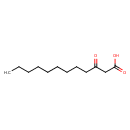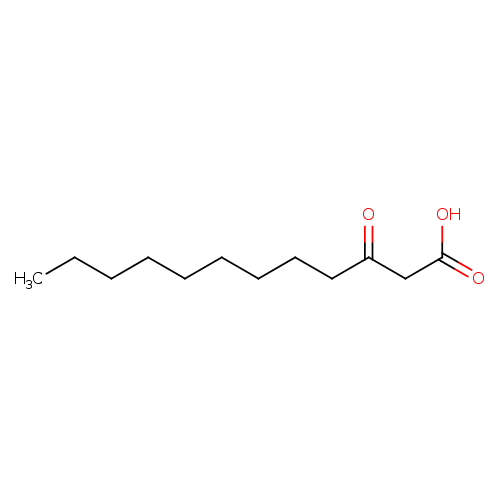|
Record Information |
|---|
| Version |
1.0 |
|---|
| Update Date |
1/22/2018 11:54:54 AM |
|---|
|
Metabolite ID | PAMDB120548 |
|---|
|
Identification |
|---|
| Name: |
3-oxo-dodecanoate |
|---|
| Description: | In humans fatty acids are predominantly formed in the liver and adipose tissue, and mammary glands during lactation. 3-Oxo-Dodecanoic acid is an intermediate in fatty acid biosynthesis. Specifically, 3-Oxo-Dodecanoic acid is converted form Malonic acid via three enzymes; 3-oxoacyl-[acyl-carrier-protein] synthase, fatty-acid Synthase and beta-ketoacyl -acyl-carrier-protein synthase II. (EC:2.3.1.41, E.C: 2.3.1.85, 2.3.1.179). |
|---|
|
Structure |
|
|---|
| Synonyms: | - 3-Oxododecanoate
- 3-oxododecanoate
|
|---|
|
Chemical Formula: |
C12H21O3 |
|---|
| Average Molecular Weight: |
213.296 |
|---|
| Monoisotopic Molecular
Weight: |
214.15689 |
|---|
| InChI Key: |
DZHSPYMHDVROSM-UHFFFAOYSA-M |
|---|
| InChI: | InChI=1S/C12H22O3/c1-2-3-4-5-6-7-8-9-11(13)10-12(14)15/h2-10H2,1H3,(H,14,15)/p-1 |
|---|
| CAS
number: |
Not Available |
|---|
| IUPAC Name: | 3-oxododecanoate |
|---|
|
Traditional IUPAC Name: |
3-oxododecanoic acid |
|---|
| SMILES: | CCCCCCCCCC(CC([O-])=O)=O |
|---|
|
Chemical Taxonomy |
|---|
|
Taxonomy Description | This compound belongs to the class of chemical entities known as medium-chain keto acids and derivatives. These are keto acids with a 6 to 12 carbon atoms long side chain. |
|---|
|
Kingdom |
Chemical entities |
|---|
| Super Class | Organic compounds |
|---|
|
Class |
Organic acids and derivatives |
|---|
| Sub Class | Keto acids and derivatives |
|---|
|
Direct Parent |
Medium-chain keto acids and derivatives |
|---|
| Alternative Parents |
|
|---|
| Substituents |
- Medium-chain keto acid
- Beta-keto acid
- 1,3-dicarbonyl compound
- Beta-hydroxy ketone
- Ketone
- Monocarboxylic acid or derivatives
- Carboxylic acid
- Carboxylic acid derivative
- Organic oxygen compound
- Organic oxide
- Hydrocarbon derivative
- Organooxygen compound
- Carbonyl group
- Aliphatic acyclic compound
|
|---|
| Molecular Framework |
Aliphatic acyclic compounds |
|---|
| External Descriptors |
|
|---|
|
Physical Properties |
|---|
| State: |
Solid |
|---|
| Charge: | -1 |
|---|
|
Melting point: |
Not Available |
|---|
| Experimental Properties: |
| Property | Value | Reference |
|---|
| Melting Point | Not Available | Not Available | | Boiling Point | Not Available | Not Available | | Water Solubility | Not Available | Not Available | | LogP | Not Available | Not Available |
|
|---|
| Predicted Properties |
|
|---|
|
Biological Properties |
|---|
| Cellular Locations: |
Not Available |
|---|
| Reactions: | |
|---|
|
Pathways: |
Not Available |
|---|
|
Spectra |
|---|
| Spectra: |
|
|---|
|
References |
|---|
| References: |
Not Available |
|---|
| Synthesis Reference: |
Not Available |
|---|
| Material Safety Data Sheet (MSDS) |
Not Available |
|---|
|
Links |
|---|
| External Links: |
|
|---|


